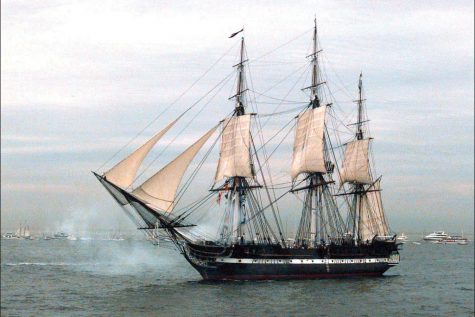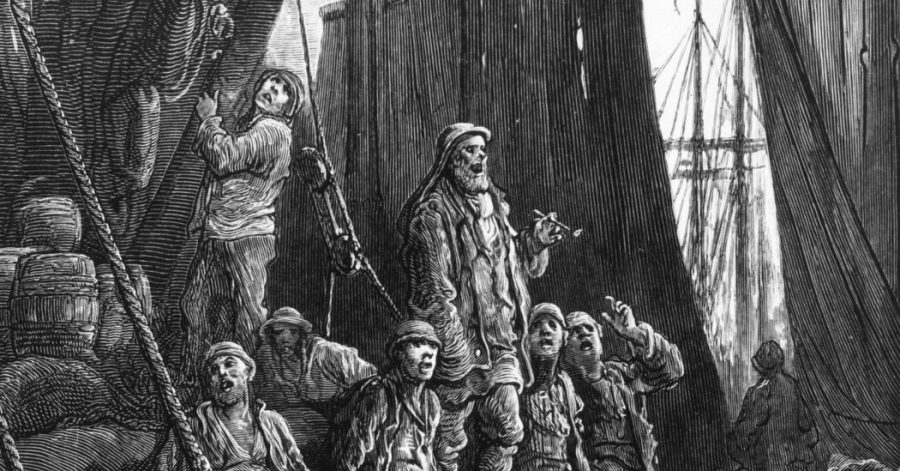The Fascinating History of Sea Shanties
January 25, 2021
Disclaimer: there are many spellings of “shanty,” some of which you will see used here. I find the most widely used version in modern day is “shanty,” which is what I have elected to use for this piece, but you may notice some variations in the spelling such as “chantey.” This was the most common spelling in the early 18th century, which is where many of my sources come from. The section on Sharp’s account uses such spelling.
Seen most recently on TikTok, the art form of sea shanties has had a dynamic rise and fall, being used across sailing ships worldwide soon after its creation only to be practically unheard of in this day and age save for a rousing rendition of “Drunken Sailor” every now and again. Bringing enjoyment to the sailors’ monotonous labor, crewmembers and captains alike would be heard singing these songs together while doing their daily tasks aboard the ship. With the rise of the steamboat, however, came the untimely demise of the sea shanty.
I became intrigued by the topic after my many different tastes in songs caused Amazon Music to recommend to me “The Mariner’s Revenge Song” by the Decemberists. This ballad of a sailor seemed to be inspired by sea shanties and instantly I wanted to know more. Even before I had heard this song, the rhythmic chanting of sea shanties had always caught my attention. This sparked a long trail of Google searches.

A sea shanty is a type of song traceable to the mid-1400s and its rhythm would be used to keep crewmembers in sync with each other. For example, one usage was to make sure the members of a rowboat would pull the oars at the same time, rowing on certain beats of the song. This method was very effective and much more enjoyable than simply counting.
According to Historic UK, the debate on the origin of “shanty” is very diverse, some claiming it comes from the French “chanter,” “to sing.” Others debate that it comes from the English “chant.”

Shanties have had their own resurgence of popularity recently on the social media app TikTok. One user, Nathan Evans is credited with the start of “ShantyTok,” a group of videos recently appearing on the app of various users singing renditions of different shanties. This trend started with Evans singing “Soon May the Wellerman Come.” Interestingly enough, this song was not a sea shanty but rather a song that whalers in New Zealand would sing. People mistake it for a sailor’s sea shanty due to both lack of information on the songs and a similar beat and subject to the songs that sailors would sing, but whalers used similar songs in their line of work.
Some say the art form’s popularity on TikTok stems from the typical quarantine boredom that people have experienced during 2020. That very well may be the case, but it can’t be denied that the songs are very catchy and sound incredible no matter the singer’s skill level. Once I found these videos, it only fueled my curiosity about these songs and where they came from.
Historic UK’s article on sea shanties mentions a book written by Cecil James Sharp, a firsthand account of sailors and the songs they sang called “English folk-chanteys: with pianoforte accompaniment, introduction and notes” published in 1914. After hours of research, even going as far as to check the Library of Congress’s website, something wonderful happened. I found Sharp’s book.
According to their website, Forgotten Books is “a London-based book publisher specializing in the restoration of old books, both fiction and non-fiction” and at the time of writing this they have 1,271,513 books available to browse. One of these books available in a pdf format happened to be Sharp’s account of sea shanties.
The introduction reveals a lot of information on the singing of these shanties as well as the songs themself as the rest of the book is filled with lyrics and music. Most of these shanties were sung to Sharp by John Short, a man who spent 50 years as a sailor and most of that time he was a designated chanteyman, the person who would sing the solos in chanteys.
Sharp mentions the two main types of chanteys: the capstan-chantey and the pulling-chantey. The purpose of the capstan-chantey is to keep a constant rhythm for tasks like rowing a boat or working the pumps. This style is similar to the marching songs of soldiers. “Whip Jamboree” is an example of a capstan-chantey. Mostly these songs would have more of a call-and-response style where the chanteyman would sing a solo and the crew would sing the chorus in response. The only requirements for a capstan-chantey was that it could be sung at the tempo needed for the job they were performing and would hold the crew’s attention.
The pulling-chantey had much stricter requirements. This was sung when more irregular work needed to be done, such as hoisting the sails, where the movements needed didn’t follow a constant pattern. The pulling-chantey ensured that the pulls would be made in sync as well as giving the crewmembers time to breathe and reset their grip on the ropes. “Poor Old Reuben Ranzo” is a pulling-chantey.

Generally the chanteyman would start by singing the refrain of his chosen song, or a shortened form of it, however not every ship did this. This would serve to remind the crew of the tune of the song as well as let them know what song he had chosen. He would then proceed to the first line of the song. For example, a chanteyman could decide to sing “Reuben Ranzo” and say “O poor old Reuben Ranzo,” to which the crew would respond “Ranzo boys Ranzo.” They would pull in sync as they sang the italicized words.
A chanteyman once told Sharp about shanties, “It was only just a few words we had, but it made the thing come lighter.”
The art form of the sea shanty has all but been lost in the modern day and age, but through recordings and sheet music as well as TikTok, it is slowly being kept alive.
For those that want a good introduction to the world of sea shanties, here are my recommendations:
A Hundred Years on the Eastern Shore – On the YouTube channel “Davide De Finis.”
Rio Grande – A rendition by the Foc’sle Singers.
All We Got – A song by YouTuber Louie Zong, reminiscent of lo-fi hiphop and remixed from samples of various sea shanties.
Anti-Sea Shanty (Pirate Punk) – Another song by Louie Zong using the rhythms and storytelling style of ballads used in sea shanties but remixed in a punk-rock styling. If you like this style of music, check out the band The Dreadnoughts for similar songs.
A Video Compilation of ShantyTok – Featuring Evans’ original video as well as people’s responses to it as well as a short history lesson for those that want to learn more about this piece.
ShantyTok Compilation – Another compilation of ShantyTok videos featuring other songs including “Drunken Sailor.”
Collection of Shanty Vocals – YouTuber Matt Dearing has compiled various singers’ renditions of sea shanties without music for those who want to experience the shanty as it would have been sung on ships.
Mass Choir Leave Her Johnny – A rendition of “Leave Her Johnny” featuring hundreds of singers around the world.









